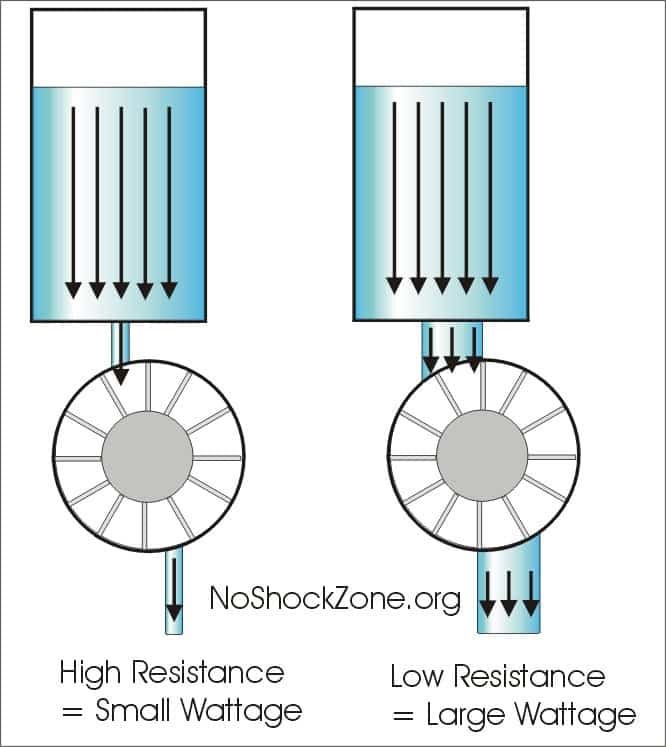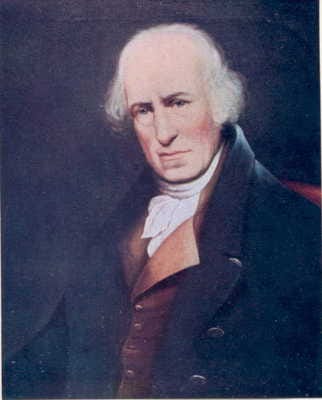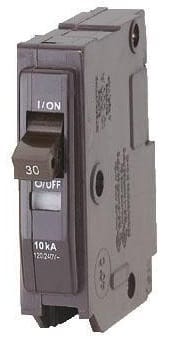As promised, here’s the next installment of my Basic Electricity Course. Class is now in session. This is an Intermediate Level article, so it’s time to flex your brain a bit. 🧐
If you’ve been reading along this far you already know about voltage (electrical pressure) and amperage (current flow). But one without the other is useless to us. In the end it all comes down to wattage.
Get to Work
We’re going to put voltage and current together and make them get to work. If you notice in the first illustration, there’s a lot of pressure at the bottom of the water tank. However, unless that pressure gets to move something, it simply sits there as stored energy just like the compressed air in a tank. Electricity works exactly the same way.
You’ll typically have around 120 volts of electrical pressure at an electrical outlet, but the air around the outlet has such high resistance to electrical flow, that the electrons just sit in the outlet waiting for a connection. So there’s no current flow unless you connect something that completes the circuit.
High Resistance to Flow
Here we’ve put a hole in the bottom of the tank connected to a pipe and see that water is flowing out under pressure. And you can imagine that flowing water could do useful work. It could turn a water wheel and make flour from wheat, it could drive a piston up and lift a heavy weight or it could even spin a turbine generator and actually make electricity.
If we put a small hole in our tank, there will be a high resistance to water flow and not much work will get done. That’s exactly what happens when you plug in an appliance that doesn’t draw much wattage, perhaps a 100-watt light bulb.
Low Resistance to Flow
But put in a larger hole and there will be a lot more water flowing since there will be less resistance to current flow. And, of course, all that extra current can be used to do even more work.
For instance, a 1,000-watt space heater needs 10 times the current flow of a 100-watt light bulb since it’s drawing 10 times more wattage, and that means 10 times the work is getting done.
So just like the difference between the stream of water from your faucet and the flow of water coming over Niagara Falls, more current and pressure equals more work getting done.
Wattage is Power
The same thing happens in your electrical outlet. Plug in an appliance with a high resistance to current flow (a small hole) and not much current will flow, like the left side of the illustration.
The turbine won’t be spinning very fast and can’t do much work. However, plug in something with a low resistance (large hole) to current flow, like the right side of the illustration, and a lot more current will flow. In this case the turbine will spin much faster and can do much more work.
That’s the basis of all electrical circuits, and why a power outlet “knows” how much wattage an appliance needs.
Appliances that need a small amount of power, like a 100-watt light bulb, will have a small electrical hole (with high resistance to flow), figuratively speaking, while other appliances, like a 1,500-watt griddle, that need much more power will have a larger electrical hole (with low resistance to flow). That built-in electrical resistance is part of the original design of the appliance, but that’s for a future article.
Inventor Alert
It takes voltage (electrical pressure) and amperage (electrical current flow) to get any work done. And that work is defined in a unit of measure called the Watt.
And like many cool discoveries that are named after a famous scientist or inventor, in this case it’s named for James Watt, the inventor of the practical steam engine which started the industrial revolution. We’re not going to bore you with all the theory, but everything from horsepower to air conditioning BTUs to burning candles can be described in watts of power.
Basic Math
Here’s the basic formula, which we’ll also use later. Volts times Amps equals Watts (V x A = W). This formula implies that if your electrical outlet is providing 120 volts and the appliance is drawing 10 amperes, that’s 1,200 watts of power doing something. Again, we’ll use this simple formula later for some more calculations, but for now we’ll use it just once to calculate how much wattage (power) is available from 20-, 30- and 50-amp campsite outlets.
20 amps times 120 volts equals 2,400 watts
30 amps times 120 volts equals 3,600 watts
50 amps times 240 volts equals 12,000 watts (6,000 watts per 120-volt leg)
What does this mean?
That suggests that if you’re plugged into a 20-amp receptacle at a campsite, you can turn on up to 2,400 watts of appliances in your RV before you exceed 20 amps of current flow and trip the circuit breaker in the pedestal.
If you’re plugged into a 30-amp receptacle, you can turn on up to 3,600 watts of appliances before you trip the breaker.
And if you’re plugged into a 50-amp 120/240-volt receptacle, you can turn on up to 6,000 watts of appliances on each leg of your power system for a total of 12,000 watts.
How Much Wattage?
How do you know how much wattage each appliance needs? Well, there are at least two ways to find out. First, you can look at any appliance to find a wattage usage statement someplace on the back panel. For instance, a 1,200-watt hair dryer draws 1,200 watts. A 1,500-watt electric skillet draws 1,500 watts. Turn both on at the same time and it adds up to 2,700 watts.
Now, if you’re plugged into a 20-amp outlet you’ve exceeded the 2,400-watt capacity of that circuit and you’ll trip the breaker in a few minutes. There’s a bit of a time delay that gives you a few seconds of grace before the breaker trips, but trip it will. Those same two appliances, however, would run successfully on a 30-amp outlet since that can provide 3,600 watts of power. And of course, a 50-amp 120/240-volt outlet can produce 6,000 watts per leg, so it would be just fine with a hair dryer and electric skillet at the same time.
Make a List
Jot down a list of everything you have in your RV that’s electrical and find its current draw. A string of 20 vintage Christmas lights with 7-watt bulbs will draw 20 times 7, which equals 140 watts. And a 1,000-watt slow-cooker might draw pretty close to 1,000 watts when on the high power setting, but much less when it’s turned to low simmer mode, maybe only 200 watts or so.
This all seems pretty intuitive until you start calculating wattage from non-heating appliances. A typical LED television might draw 100 watts of power, and that laptop computer might draw 50 to 75?watts from its power supply, which all seems simple enough. But motor-based appliances like your air conditioner or refrigerator will draw a peak of many times their rated wattage just to get things spinning inside.
More on this in a later article, but that’s why generators are always more finicky about starting an RV air conditioner compared to an electrical outlet that’s connected to the power company. The circuit breaker in a campsite pedestal is much more forgiving of a temporary overload, while a generator will try to protect itself and shut off the power if its peak wattage draw is exceeded for even a fraction of a second.
Measure It
The second way to find out how much current an appliance draws is to actually measure it. You can get a kilowatt meter that will allow you to plug in your appliances one at a time and actually measure how much wattage they’re drawing from the outlet. That’s also a good way to find out if your electrical conservation efforts are paying off by purchasing more “green” appliances. Here’s what I bought last year for some of my field experiments. You can find it on Amazon HERE.
And this kind of wattmeter will allow you to discover all sorts of things about lost power in appliances. For instance, a microwave rated for 700 watts of cooking power (not the wattage usage number stated on the back panel) probably draws 1,000 watts or more from the power line. Where did those [additional] 300 watts of power go? Well, that discrepancy is due to the inefficiencies of the microwave generating process.
So those other 300 watts turn into heat within the cabinet, which must be vented as warm air. You may not worry much about this until you find that those extra 300 watts put you over the edge and you trip a circuit breaker trying to run the 1,200-watt coffee pot and 700-watt (actually 1,000) microwave at the same time your refrigerator compressor kicks in.
And the big wattage item in any RV is the air conditioner, which draws a lot of inrush current on startup. So when all these currents add up beyond the capability of the circuit breaker, the breaker trips and it’s lights out, literally.
How Much is Too Much?
A good rule of thumb is not to exceed around 85% of your wattage capacity simply by adding up the appliances you’ll turn on at the same time. So that means that a 20-amp receptacle that can produce 2,400 watts of power probably should not be used to draw more than 2,000 watts continuously. That adds some extra padding for appliances that need a little extra “kick” at startup.
The same rule applies to a 30-amp outlet that can produce 3,600 watts. Try not to run more than 3,000 watts of “planned” wattage and you probably won’t trip the incoming circuit breaker. And a 50-amp 120/240-volt receptacle has enough wattage to run a small house, which is exactly what you’re doing. They can easily handle 5,000 watts per leg without tripping.
Of course, some of you will want to squeeze every last watt out of the campsite pedestal, so in that case make sure you use a heavy enough extension cord that’s as short as possible from the RV to the campsite receptacle.
Breaker, Breaker…
What happens if you pull too much wattage from a campsite receptacle? Well, if you’ve sized your extension cord properly and the campsite has wired everything correctly, you’ll simply trip the circuit breaker. That’s exactly the job it’s supposed to do and nothing should be harmed from the shutdown.
However, if you have an air conditioner running at the time of power outage, know that they need around 2 1/2 minutes for the compressor to lose its head pressure and allow it to restart properly. So give things a few minutes to rest while you turn off your appliances. Then reset the circuit breaker by turning it hard all the way OFF first, then flipping it to the ON position. If it holds in the ON position properly, you probably just had a momentary overload. However, if you smell something burning or the circuit breaker trips off again immediately, stop what you’re doing and get an electrician to find out what’s wrong with your rig. Don’t keep flipping a breaker ON that keeps tripping OFF as there’s certainly something wrong that can cause additional electrical damage to your RV’s appliances if you keep applying power. We call that a “smoke test,” and you really don’t want to go down that path.
Quick Tips
A 20-amp service can supply 2,400 watts
A 30-amp service can supply 3,600 watts
A 50-amp 120/240 service can supply 12,000 watts (6,000 watts per each 120-Volt leg)
If you turn ON a circuit breaker and it trips OFF right away, contact an electrician immediately to find the cause of the problem
Let’s play safe out there… Mike












